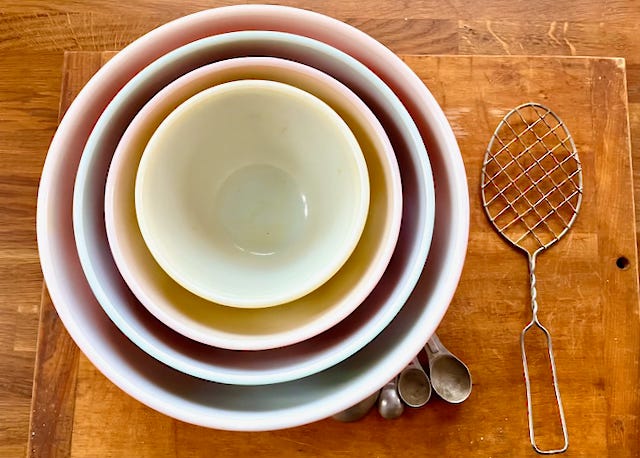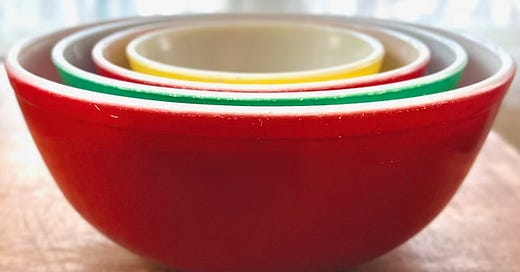My mother grew up on a small farm in the cold middle of the country. Like many of her generation, she was shaped by poverty. It was a hurt that baffled me until I moved out on my own, and lived in a way I doubt most people would have found tolerable. I had heat and running water and enough of an income to buy books. Our hungers were not the same.
But there were times when I thought of the farm, and my grandmother’s hug, as wide as the door next to the big lilac, and felt a crush of sorrow. The farm had been flattened to build a road. Not even a real road. Just gravel. Her childhood was gone. This was something I understood.
As the land wasn’t fit to grow much of anything, they raised dairy cattle. Pastures and the crops that cattle required took up most of the small acreage. Later, during better times, the family ate chickens, vegetables, jam and fruit pies. There was butter, coffee, cream, rich milk. Sides of beef hung in the cold shed. My grandmother baked a dozen loaves of bread daily in her wood-fired stove. Potatoes were served at every meal. Even during the Depression, if there was no other food on the plate, there were potatoes. Boiled until gray, but you could still eat them. You had to.
Eleven children lived in the small crooked house my grandfather built. I can’t say he was crooked, as so many meanings attach to that word. He was bent like a rusty nail.
Of five daughters, the three eldest spent their days indoors, helping Grandma. My mother and an aunt joined — though that is not the correct word — her brothers in the fields and barn.
“I worked like a horse,” she frequently said, meaning My father worked me like a horse. As two of the three housebound sisters fled at an early age into marriage, and the third stiffened into a lifetime of silence, she was better off. I never said that out loud. She needed to release her pain; I was there to absorb it.
And despite the milking, the cleaning of stalls, and the shoveling of hay and manure, my mother became an excellent seamstress and learned a few kitchen skills. With her strong arms, she handed on to me what she could.
She gave me her sponge cake.
That may not sound like much. But for every occasion — picnics, family gatherings, church socials, ladies’ luncheons — it was incumbent on her to bring one, lest there be rioting in the streets. She lightened somber funeral receptions with that gloriously tall column sheathed in seven-minute frosting. She was generous with the recipe, not leaving out the one critical ingredient as some people do (yes, I’m guilty of “forgetting” a certain seasoning that goes into my potato salad). But nobody ever made my mother’s cake the way she did.
She baked it for every birthday party. All of the candles were new out of the box. She made sure that the birthday child got the first slice. And sometimes on an ordinary school day, we came home to a warm, fragrant house. The cake rested on the counter, cooling upside down on a skinny aluminum cone.
My brothers and I fought over the crust. We pulled off strips and devoured them.
“Crazy kids,” my mother said. “You’re like a bunch of wild animals.” Nothing pleased her more.
For many years before her death, I prodded her to enter it at the State Fair. “Come on, Mom. Your cake’s the best. Anyone can see that.” Finally, she gave in.
I guided her through the crowded Creative Activities Building, past the quilts and crocheted afghans and the backlit displays of jewel-toned jellies and pickled beets. It took some time to find her entry, on the bottom shelf of a glass case at the back of the building.
“Look, Mom. You got a ribbon!” It was pink. Out of five cakes, hers had come in last.
“Really? They liked mine?”
“They loved it!”
Fifth place: ha. First through fourth owned the judges. Not to mention a certain well-known food corporation in a city built by the milling of flour. We went to the nearby church dining hall and had egg coffee and meat loaf. Too much excitement for one day. I drove her home.
She never bragged about the small rectangle of cheap satin with the peeling gold letters. I found it in the bottom drawer of her dresser after she died, along with the high school diploma she earned in her fifties. I have them both, somewhere. But what I treasure most is her nested set of Pyrex mixing bowls.
There are four of them. Red, green, red, yellow. At age four, it delighted me that these were the colors of traffic lights. I was learning that there are rules in the world. All of them kept us safe. Going through a red light was as bad as stealing.
I learned about recipes, too. About ingredients, measurements, and the laws of nature that governed them. If you used a half teaspoon when a teaspoon was called for, you might as well just throw the whole thing in the trash. Except that you couldn’t do that, because wasting food was a sin. And it might lead to something even worse, like taking the Lord’s name in vain. You had to get it right the first time.

One rule was about eggs. Yolks had to be separated from whites so completely that not a single speck of yellow contaminated the whites. A dozen yolks went into the green bowl; the whites, viscous and sloppy, into the big red one. My mother added half a cup of flour and two-thirds of a cup of sugar to the yolks. She beat them with a hand mixer for five minutes, until they drizzled from the beaters in a thin yellow ribbon.
Then came the miraculous part.
Holding the bowl of egg whites against her hips as you would a baby, the flat whisk flashing across the surface, a quarter-teaspoon of salt and half a teaspoon of cream of tartar went in so fast you barely saw it happen. Tossing in the remaining one-third cup of sugar, a tablespoon at a time, she created a glossy white nimbus that could have lifted Christ into heaven. She set the bowl on the counter to add a teaspoon of almond extract, then reached for the yolk mixture. After folding it into the whites with a rubber spatula, she poured shimmering ribbons of batter into the tube pan and eased it into the oven to bake for fifty minutes.
I held my breath.
She opened the oven door, pulled the rack forward with stained potholders, and lifted the cake with its fragrant, crusted surface towards the ceiling, as if dedicating a life to God. She set it on the cone until it was time to run a knife around the edge, separating the cake from the pan.
Then, rapture.
I’d love to invite you over for a piece of my mother’s cake. I have her bowls, whisk, measuring spoons, and a lot of determination. Still working on the biceps, but I allow myself to take an occasional rest.
Two-thirds of a cup of sugar, beaten with yolks and flour. Yes, I do that. I add the remaining one-third cup exactly as she did, beating it gradually into the whites. One cup of sugar, divided, is what the recipe says.
And yet, it’s as if that cup remains divided. An element of remembered sweetness is pierced through with dissatisfaction. It doesn’t nest, as the bowls do, in the orderly comfort I crave. My kids eat it, though they agree it’s not as good as Grandma’s.
I lack my mother’s faith.
Could that be the missing ingredient?
And now I have some questions for you.
Is there a spiritual element from your childhood, a memory evoked by the taste, smell, or even the thought of a special food? Do you long to recapture that feeling? If so, through what channels do you search?
Let me know in the comments.
Seriously, folks. Let me know in the comments.
All subscribers will receive my newsletters in your inbox at least once a week, and can read and comment on all posts. If you value my work and have the means to do so,* please consider becoming a paid subscriber. You’ll get bonus personal notes and a surprise gift or two. Right now, I’m offering annual subscriptions for $35. That’s 30% off the regular price, until the end of time. All readers have my undying gratitude.
*If money is an issue, no worries. Just let me know and I will comp you.






Why read Proust when I can read Mary Roblyn?
Mary, what a beautiful story. I come from a long line of Chefs and I spent 40 years as a very successful one myself, your story resonates with me on so many levels. Especially the bread baking. During covid pandemic I made 150 loaves a week in my oven, no bread machine for me lol. I donated the loaves, 75 white and 75 wheat loaves, to our 3 local food pantries and anyone who requested a loaf or two that was unable to make it to the pantry. Anthony joined in to help me and it's one of my most treasured memories of us.
Thank you for sharing.